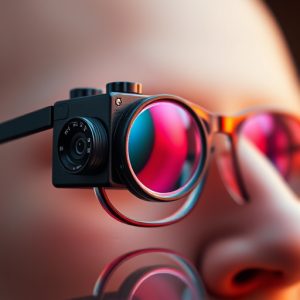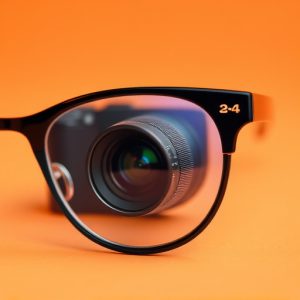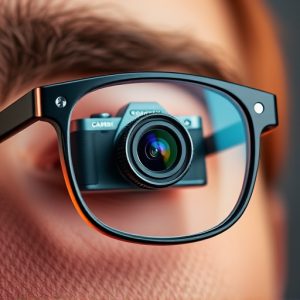Glasses with Camera Built-in: Benefits, Quality, Future Prospects
Glasses with a camera built-in (smart glasses) seamlessly blend technology and fashion, offering han…….
Glasses with a camera built-in (smart glasses) seamlessly blend technology and fashion, offering hands-free capture of high-quality images and videos integrated into our physical world. With enhanced image quality, advanced sensors, and mobile device integration, they revolutionize sectors like healthcare and augmented reality. These smart glasses enable improved visual storytelling, creative expression, and real-time digital interactions, with potential AI features like object recognition and translation expanding their utility in daily life.
In an era driven by technological innovation, smart glasses equipped with cameras are transforming the way we interact with our surroundings. This article delves into the intriguing world of glasses with a camera built-in, exploring their functionality and the profound impact they have on various aspects of daily life. From enhanced augmented reality experiences to improved communication, these devices offer a unique blend of convenience and cutting-edge technology. We’ll dissect their benefits, delve into technical considerations, and look ahead at what the future holds for this exciting integration.
Understanding Glasses with Built-in Cameras: A Brief Overview
Glasses with a camera built-in, often referred to as smart glasses or augmented reality (AR) eyewear, have emerged as an exciting fusion of technology and fashion. These innovative devices offer more than just corrective or protective vision aid; they provide a window into a digital world seamlessly integrated with our physical environment. By integrating cameras directly into the lenses, these glasses enable users to capture moments, interact with digital content, and even enhance their visual experiences in real-time.
The concept behind glasses with a camera built-in is to create a hands-free, unobtrusive way to engage with technology. Whether for photography, video calls, or augmented reality applications, these cameras offer convenience and versatility. With advancements in compact imaging technology, manufacturers have been able to design sleek frames that house high-quality sensors, ensuring users can enjoy crisp images and videos without compromising on style or comfort.
Benefits and Applications of This Technological Integration
The integration of cameras into everyday glasses offers a multitude of benefits and opens up exciting applications for both personal and professional use. With a camera built directly into wearable glasses, users can capture high-quality images and videos hands-free, providing an innovative way to document life experiences. This technology is particularly advantageous in scenarios where traditional cameras might be cumbersome or impractical, such as during outdoor activities, travel, or even virtual meetings.
Glasses with a camera built in provide enhanced visual storytelling capabilities, allowing wearers to share their perspective seamlessly. It facilitates new forms of creative expression and enables the capture of unique, first-person viewpoints. Moreover, its applications extend beyond personal use; it can revolutionize fields like remote healthcare, offering telemedicine solutions with real-time video consultations, or enhance augmented reality experiences by overlaying digital information onto the physical world.
How Camera Quality is Determined in Smart Glasses
The camera quality in smart glasses is determined by several key factors, all working in harmony to capture crisp and clear images. Firstly, the resolution of the sensor plays a vital role; higher resolution sensors can capture more detail, resulting in sharper pictures. Smart glasses with a built-in camera often employ advanced sensors that can compete with traditional cameras in terms of clarity.
Additionally, the lens system is crucial; it affects the focus, field of view, and overall image quality. Advanced glass surfaces and coatings are used to reduce distortions and enhance light transmission, ensuring accurate color representation. Software optimization also plays its part, as algorithms process the raw data from the sensor, improving low-light performance and enabling features like automatic focus and image stabilization, which are essential for steady and clear shots when worn on the face.
Future Prospects and Considerations for Consumers
With the rapid advancements in technology, glasses with a camera built-in are expected to evolve significantly in the future, offering consumers enhanced experiences and capabilities. These smart glasses could potentially revolutionize various sectors, from everyday consumer use to professional applications. Improved image quality, advanced sensors, and better integration with mobile devices are likely to be key areas of focus for manufacturers. This will enable users to capture high-definition footage, access augmented reality features, and seamlessly share or stream content directly from their glasses.
For consumers, this evolution presents exciting prospects. Glasses with integrated cameras could become versatile tools for documentation, creativity, and communication. They may offer new ways to interact with digital content, enhancing mobile experiences and enabling hands-free, eyes-free operation. As technology becomes more sophisticated, these devices might even incorporate advanced AI features, such as object recognition, scene understanding, or real-time translation, further expanding their utility in everyday life.


